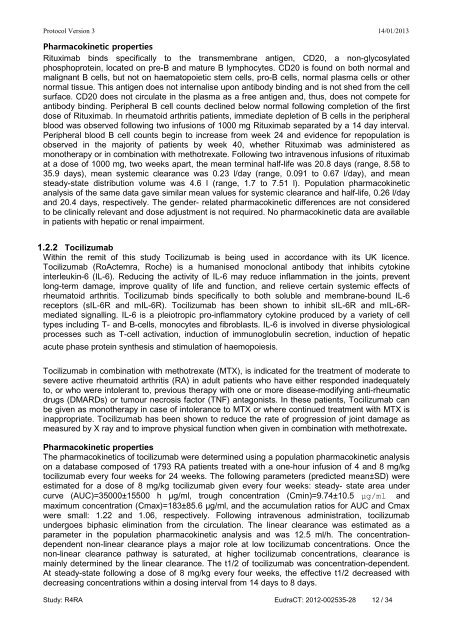Protocol Title : A Randomised, open labelled study in anti ... - EME
Protocol Title : A Randomised, open labelled study in anti ... - EME
Protocol Title : A Randomised, open labelled study in anti ... - EME
Create successful ePaper yourself
Turn your PDF publications into a flip-book with our unique Google optimized e-Paper software.
<strong>Protocol</strong> Version 3 14/01/2013<br />
Pharmacok<strong>in</strong>etic properties<br />
Rituximab b<strong>in</strong>ds specifically to the transmembrane <strong>anti</strong>gen, CD20, a non-glycosylated<br />
phosphoprote<strong>in</strong>, located on pre-B and mature B lymphocytes. CD20 is found on both normal and<br />
malignant B cells, but not on haematopoietic stem cells, pro-B cells, normal plasma cells or other<br />
normal tissue. This <strong>anti</strong>gen does not <strong>in</strong>ternalise upon <strong>anti</strong>body b<strong>in</strong>d<strong>in</strong>g and is not shed from the cell<br />
surface. CD20 does not circulate <strong>in</strong> the plasma as a free <strong>anti</strong>gen and, thus, does not compete for<br />
<strong>anti</strong>body b<strong>in</strong>d<strong>in</strong>g. Peripheral B cell counts decl<strong>in</strong>ed below normal follow<strong>in</strong>g completion of the first<br />
dose of Rituximab. In rheumatoid arthritis patients, immediate depletion of B cells <strong>in</strong> the peripheral<br />
blood was observed follow<strong>in</strong>g two <strong>in</strong>fusions of 1000 mg Rituximab separated by a 14 day <strong>in</strong>terval.<br />
Peripheral blood B cell counts beg<strong>in</strong> to <strong>in</strong>crease from week 24 and evidence for repopulation is<br />
observed <strong>in</strong> the majority of patients by week 40, whether Rituximab was adm<strong>in</strong>istered as<br />
monotherapy or <strong>in</strong> comb<strong>in</strong>ation with methotrexate. Follow<strong>in</strong>g two <strong>in</strong>travenous <strong>in</strong>fusions of rituximab<br />
at a dose of 1000 mg, two weeks apart, the mean term<strong>in</strong>al half-life was 20.8 days (range, 8.58 to<br />
35.9 days), mean systemic clearance was 0.23 l/day (range, 0.091 to 0.67 l/day), and mean<br />
steady-state distribution volume was 4.6 l (range, 1.7 to 7.51 l). Population pharmacok<strong>in</strong>etic<br />
analysis of the same data gave similar mean values for systemic clearance and half-life, 0.26 l/day<br />
and 20.4 days, respectively. The gender- related pharmacok<strong>in</strong>etic differences are not considered<br />
to be cl<strong>in</strong>ically relevant and dose adjustment is not required. No pharmacok<strong>in</strong>etic data are available<br />
<strong>in</strong> patients with hepatic or renal impairment.<br />
1.2.2 Tocilizumab<br />
With<strong>in</strong> the remit of this <strong>study</strong> Tocilizumab is be<strong>in</strong>g used <strong>in</strong> accordance with its UK licence.<br />
Tocilizumab (RoActemra, Roche) is a humanised monoclonal <strong>anti</strong>body that <strong>in</strong>hibits cytok<strong>in</strong>e<br />
<strong>in</strong>terleuk<strong>in</strong>-6 (IL-6). Reduc<strong>in</strong>g the activity of IL-6 may reduce <strong>in</strong>flammation <strong>in</strong> the jo<strong>in</strong>ts, prevent<br />
long-term damage, improve quality of life and function, and relieve certa<strong>in</strong> systemic effects of<br />
rheumatoid arthritis. Tocilizumab b<strong>in</strong>ds specifically to both soluble and membrane-bound IL-6<br />
receptors (sIL-6R and mIL-6R). Tocilizumab has been shown to <strong>in</strong>hibit sIL-6R and mIL-6Rmediated<br />
signall<strong>in</strong>g. IL-6 is a pleiotropic pro-<strong>in</strong>flammatory cytok<strong>in</strong>e produced by a variety of cell<br />
types <strong>in</strong>clud<strong>in</strong>g T- and B-cells, monocytes and fibroblasts. IL-6 is <strong>in</strong>volved <strong>in</strong> diverse physiological<br />
processes such as T-cell activation, <strong>in</strong>duction of immunoglobul<strong>in</strong> secretion, <strong>in</strong>duction of hepatic<br />
acute phase prote<strong>in</strong> synthesis and stimulation of haemopoiesis.<br />
Tocilizumab <strong>in</strong> comb<strong>in</strong>ation with methotrexate (MTX), is <strong>in</strong>dicated for the treatment of moderate to<br />
severe active rheumatoid arthritis (RA) <strong>in</strong> adult patients who have either responded <strong>in</strong>adequately<br />
to, or who were <strong>in</strong>tolerant to, previous therapy with one or more disease-modify<strong>in</strong>g <strong>anti</strong>-rheumatic<br />
drugs (DMARDs) or tumour necrosis factor (TNF) antagonists. In these patients, Tocilizumab can<br />
be given as monotherapy <strong>in</strong> case of <strong>in</strong>tolerance to MTX or where cont<strong>in</strong>ued treatment with MTX is<br />
<strong>in</strong>appropriate. Tocilizumab has been shown to reduce the rate of progression of jo<strong>in</strong>t damage as<br />
measured by X ray and to improve physical function when given <strong>in</strong> comb<strong>in</strong>ation with methotrexate.<br />
Pharmacok<strong>in</strong>etic properties<br />
The pharmacok<strong>in</strong>etics of tocilizumab were determ<strong>in</strong>ed us<strong>in</strong>g a population pharmacok<strong>in</strong>etic analysis<br />
on a database composed of 1793 RA patients treated with a one-hour <strong>in</strong>fusion of 4 and 8 mg/kg<br />
tocilizumab every four weeks for 24 weeks. The follow<strong>in</strong>g parameters (predicted mean±SD) were<br />
estimated for a dose of 8 mg/kg tocilizumab given every four weeks: steady- state area under<br />
curve (AUC)=35000±15500 h μg/ml, trough concentration (Cm<strong>in</strong>)=9.74±10.5 μg/ml and<br />
maximum concentration (Cmax)=183±85.6 μg/ml, and the accumulation ratios for AUC and Cmax<br />
were small: 1.22 and 1.06, respectively. Follow<strong>in</strong>g <strong>in</strong>travenous adm<strong>in</strong>istration, tocilizumab<br />
undergoes biphasic elim<strong>in</strong>ation from the circulation. The l<strong>in</strong>ear clearance was estimated as a<br />
parameter <strong>in</strong> the population pharmacok<strong>in</strong>etic analysis and was 12.5 ml/h. The concentrationdependent<br />
non-l<strong>in</strong>ear clearance plays a major role at low tocilizumab concentrations. Once the<br />
non-l<strong>in</strong>ear clearance pathway is saturated, at higher tocilizumab concentrations, clearance is<br />
ma<strong>in</strong>ly determ<strong>in</strong>ed by the l<strong>in</strong>ear clearance. The t1/2 of tocilizumab was concentration-dependent.<br />
At steady-state follow<strong>in</strong>g a dose of 8 mg/kg every four weeks, the effective t1/2 decreased with<br />
decreas<strong>in</strong>g concentrations with<strong>in</strong> a dos<strong>in</strong>g <strong>in</strong>terval from 14 days to 8 days.<br />
Study: R4RA EudraCT: 2012-002535-28 12 / 34



